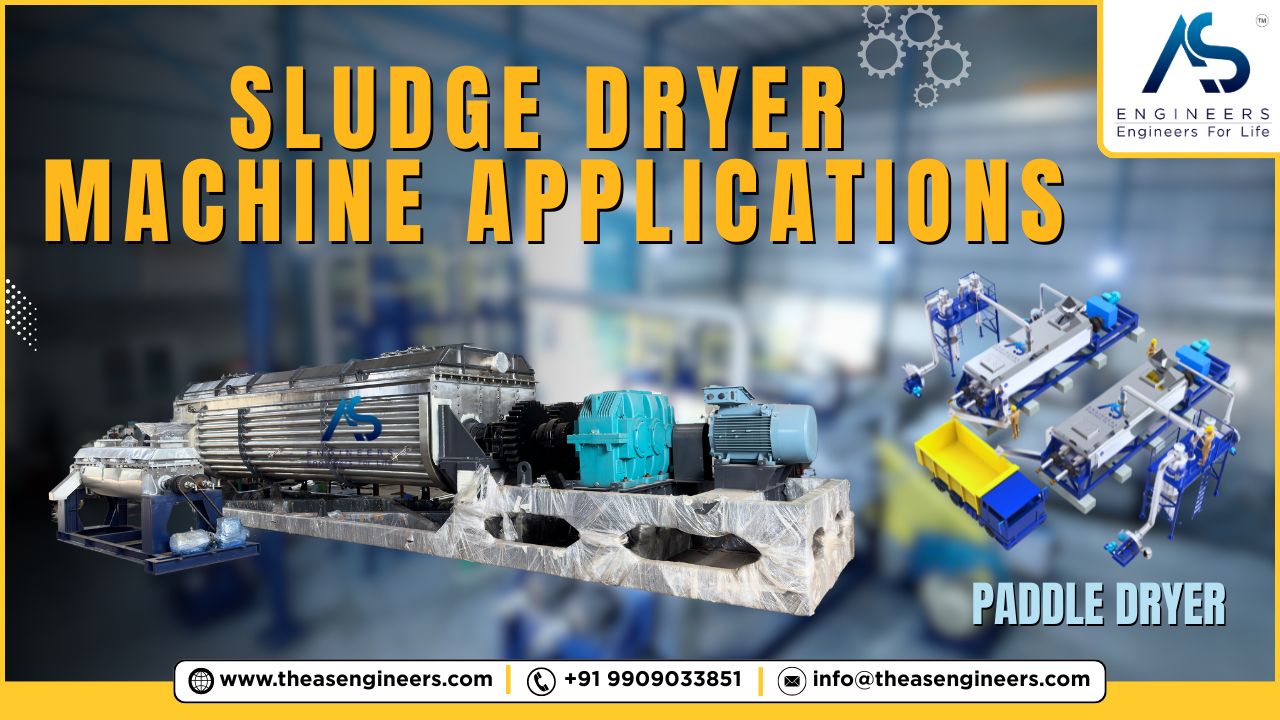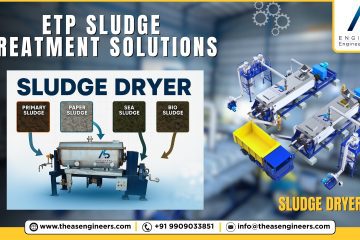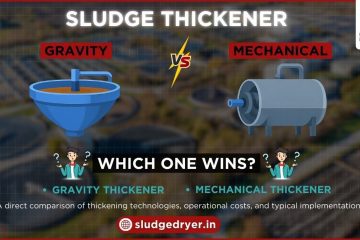Municipal wastewater treatment plants worldwide generate over 45 million tons of sludge annually, creating a massive disposal challenge that costs billions in management fees. The application scope of sludge dryer machine technology has revolutionized how industries handle this wet waste, transforming what was once an expensive disposal problem into a valuable resource recovery opportunity. Whether you’re managing a paper mill, food processing facility, or municipal treatment plant, understanding where and how sludge dryers apply to your operations can slash disposal costs by up to 80% while creating revenue streams from dried biosolids.
This comprehensive guide reveals the extensive applications of sludge dryer machines across industries, helping you identify opportunities to optimize your waste management strategy and potentially discover new profit centers within your existing operations.
Table of contents
- Primary Industrial Applications of Sludge Dryer Machines
- Specialized Application Sectors
- Emerging Application Areas
- Technology Selection Considerations by Application
- Regulatory Considerations Across Applications
- Economic Benefits Across Application Sectors
- Implementation Considerations by Application Type
- Frequently Asked Questions
- Maximizing Your Sludge Dryer Investment
Primary Industrial Applications of Sludge Dryer Machines
Municipal Wastewater Treatment Plants
Municipal wastewater treatment facilities represent the largest application scope for sludge dryer machines. These facilities process millions of gallons of wastewater daily, generating substantial volumes of wet sludge that requires efficient handling and disposal.
Key Applications:
- Primary sludge drying: Raw settled solids from preliminary treatment processes
- Activated sludge processing: Biological treatment residuals with high moisture content
- Digested sludge management: Anaerobically or aerobically digested biosolids
- Combined sludge streams: Mixed primary and secondary treatment residuals
The thermal drying process reduces sludge volume by 60-80%, dramatically cutting transportation and disposal costs. Modern indirect heating dryer systems operate at temperatures between 150-200°C, effectively eliminating pathogens while preserving nutrient content for beneficial reuse applications.
Paper and Pulp Industry
Paper manufacturing generates enormous quantities of fiber-rich sludge during the deinking and clarification processes. The application scope of sludge dryer machine technology in this sector focuses on recovering valuable fiber content while reducing disposal volumes.
Specific Applications:
- Deinking sludge processing: Removing moisture from ink flotation residuals
- Primary clarifier sludge: Drying suspended solids from initial treatment
- Biological treatment sludge: Processing secondary treatment residuals
- Coating kitchen waste: Handling paper coating preparation residuals
The dried output often contains 15-25% recoverable fiber, creating opportunities for paper mills to recycle materials back into production processes or sell as alternative fuel sources.
Food Processing and Beverage Industries
Food processing operations produce high-organic-content sludge that requires specialized handling due to rapid degradation potential. Sludge dryer machines in this application scope must address both moisture removal and pathogen elimination.
Common Applications:
- Dairy processing waste: Handling protein-rich sludge from cheese and milk production
- Meat processing residuals: Drying fat and protein-laden waste streams
- Brewery and distillery sludge: Processing yeast and grain-based residuals
- Fruit and vegetable processing: Managing seasonal high-volume organic waste
The dried biosolids from food processing often achieve Class A biosolids standards, enabling use as soil amendments or organic fertilizer products.
Textile and Dyeing Operations
Textile manufacturing creates complex sludge containing dyes, chemicals, and fiber residuals. The application scope of sludge dryer machine technology addresses both volume reduction and hazardous material stabilization.
Key Processing Areas:
- Dyeing process sludge: Removing moisture while containing chemical residuals
- Textile finishing waste: Handling chemical treatment residuals
- Fabric washing sludge: Processing detergent and sizing agent residuals
- Color separation waste: Managing dye-contaminated treatment residuals
Proper thermal drying often enables hazardous sludge reclassification, reducing disposal costs and regulatory compliance burdens.
Specialized Application Sectors
Pharmaceutical Manufacturing
Pharmaceutical production generates sludge containing active compounds that require careful handling and potential destruction. Sludge dryer machines in this application scope must meet strict containment and processing standards.
Critical Applications:
- API manufacturing waste: Handling active pharmaceutical ingredient residuals
- Formulation process sludge: Processing tablet and capsule production waste
- Quality control waste: Managing laboratory and testing residuals
- Cleaning validation waste: Handling equipment washdown residuals
The controlled thermal environment in modern dryer systems can effectively destroy pharmaceutical residuals while achieving required volume reduction.
Chemical Processing Plants
Chemical manufacturing creates diverse sludge types requiring specialized drying approaches. The application scope varies significantly based on chemical composition and hazard classifications.
Processing Categories:
- Catalyst recovery sludge: Drying precious metal-containing residuals
- Neutralization sludge: Processing acid-base treatment residuals
- Precipitation sludge: Handling metal hydroxide and sulfide residuals
- Organic synthesis waste: Managing reaction byproduct residuals
Many chemical processing applications focus on resource recovery, with dried sludge containing valuable metals or compounds suitable for reclamation processes.
Mining and Mineral Processing
Mining operations generate massive sludge volumes from ore processing and water treatment activities. Sludge dryer applications in this sector emphasize volume reduction and potential metal recovery.
Primary Applications:
- Tailings pond sludge: Processing mineral extraction residuals
- Acid mine drainage sludge: Handling environmental treatment residuals
- Flotation process waste: Managing mineral separation residuals
- Heap leach sludge: Processing precious metal extraction waste
The dried output often contains concentrated metals suitable for secondary recovery processes or specialized disposal in lined facilities.
Emerging Application Areas
Aquaculture Operations
Fish farming operations generate substantial sludge from feed waste and biological processes. This emerging application scope focuses on nutrient recovery and environmental compliance.
Key Applications:
- Settling pond sludge: Processing fish waste and uneaten feed
- Biofilter backwash: Handling biological treatment residuals
- Hatchery waste: Managing high-protein juvenile fish production residuals
- Processing plant waste: Drying fish processing byproducts
The dried biosolids often contain high nitrogen and phosphorus levels, creating valuable fertilizer products for agricultural applications.
Biogas Production Facilities
Anaerobic digestion facilities producing biogas generate spent digestate requiring further processing. Sludge dryer applications help maximize biogas plant efficiency and profitability.
Processing Applications:
- Digestate dewatering: Removing moisture from anaerobic digestion residuals
- Solid fraction processing: Handling separated fiber-rich materials
- Liquid fraction concentration: Processing nutrient-rich liquid streams
- Co-substrate residuals: Managing food waste and organic material residuals
The dried digestate often meets organic fertilizer standards, creating additional revenue streams for biogas operations.
Hospital and Healthcare Facilities
Healthcare facilities generate pathogen-rich sludge requiring specialized treatment approaches. This application scope emphasizes pathogen destruction and safe disposal.
Critical Applications:
- Medical waste treatment: Processing infectious material residuals
- Laboratory waste: Handling biological testing residuals
- Pathological waste: Managing tissue and biological material residuals
- Pharmaceutical disposal: Processing expired medication residuals
The high-temperature thermal drying process effectively destroys pathogens while reducing disposal volumes and associated costs.
Technology Selection Considerations by Application
Direct vs. Indirect Heating Systems
The choice between direct and indirect heating dryer systems depends heavily on application requirements and sludge characteristics.
Direct Heating Applications:
- Municipal biosolids with minimal odor concerns
- Non-hazardous industrial sludge
- Applications requiring maximum energy efficiency
- Situations where air emissions can be effectively managed
Indirect Heating Applications:
- Hazardous or toxic sludge requiring containment
- Applications with strict odor control requirements
- Situations requiring inert atmosphere processing
- High-value material recovery applications
Paddle Dryer vs. Rotary Dryer Selection
Different dryer technologies suit specific application requirements and sludge characteristics.
Paddle Dryer Applications:
- High-solids content sludge (>15% dry solids)
- Sticky or adhesive materials
- Applications requiring gentle product handling
- Situations with limited installation space
Rotary Dryer Applications:
- Low-solids content sludge (<15% dry solids)
- Free-flowing materials
- High-throughput applications
- Situations requiring maximum heat transfer efficiency
Regulatory Considerations Across Applications
Environmental Compliance Requirements
Different applications face varying regulatory requirements that influence sludge dryer selection and operation.
Key Regulatory Areas:
- Air emissions control: VOC, particulate, and odor management requirements
- Pathogen reduction standards: Class A and Class B biosolids requirements
- Hazardous waste classification: RCRA and state-specific requirements
- Worker safety regulations: OSHA and process safety management requirements
Understanding applicable regulations helps optimize dryer system design and operation for specific applications.
Beneficial Reuse Opportunities
Many applications create opportunities for beneficial reuse of dried sludge, transforming waste disposal costs into revenue opportunities.
Common Reuse Applications:
- Agricultural soil amendment: Class A biosolids for crop production
- Landscaping and turf management: Dried biosolids for non-food applications
- Alternative fuel production: High-BTU dried sludge for energy recovery
- Construction material applications: Dried sludge for cement and concrete production
Economic Benefits Across Application Sectors
Cost Reduction Opportunities
Sludge dryer implementation creates multiple cost reduction opportunities across different applications.
Primary Cost Savings:
- Transportation cost reduction: 60-80% volume reduction cuts hauling expenses
- Disposal fee reduction: Lower disposal costs due to reduced volumes
- Regulatory compliance: Reduced liability and permitting costs
- Labor cost savings: Automated systems reduce manual handling requirements
Revenue Generation Potential
Many applications create opportunities for revenue generation from dried sludge products.
Revenue Opportunities:
- Biosolids sales: Class A biosolids command premium prices
- Energy recovery: High-BTU dried sludge suitable for fuel applications
- Nutrient recovery: Phosphorus and nitrogen recovery for fertilizer production
- Metal recovery: Precious metal recovery from specific industrial applications
Implementation Considerations by Application Type
Site-Specific Design Requirements
Different applications require customized dryer system designs to optimize performance and compliance.
Design Considerations:
- Available space: Footprint limitations affect equipment selection
- Utility availability: Steam, electricity, and natural gas access requirements
- Environmental conditions: Climate and weather considerations
- Integration requirements: Compatibility with existing treatment processes
Operational Optimization Strategies
Successful sludge dryer implementation requires application-specific operational approaches.
Optimization Areas:
- Feed preparation: Optimal solids content and consistency for specific applications
- Temperature control: Application-specific temperature profiles for optimal drying
- Residence time: Balancing throughput with quality requirements
- Energy recovery: Heat integration opportunities for improved efficiency
Frequently Asked Questions
- What industries benefit most from sludge dryer machine applications?
Municipal wastewater treatment, paper/pulp, food processing, and chemical manufacturing industries see the greatest benefits due to high sludge volumes and strict disposal regulations. - How do sludge dryers handle different types of industrial waste?
Modern thermal drying systems adjust temperature, residence time, and atmosphere control to accommodate various sludge types, from municipal biosolids to hazardous industrial waste. - What are the typical volume reduction rates across different applications?
|Most applications achieve 60-80% volume reduction, with exact rates depending on initial moisture content and target dryness levels. - Can sludge dryers process mixed waste streams from multiple sources?
Yes, properly designed systems can handle mixed streams, though compatibility testing and regulatory approval may be required for combined processing. - What maintenance requirements should be expected across different applications? Maintenance needs vary by application, with corrosive or abrasive materials requiring more frequent component replacement and specialized materials of construction.
Maximizing Your Sludge Dryer Investment
The application scope of sludge dryer machine technology continues expanding as industries recognize the dual benefits of waste volume reduction and resource recovery. From municipal treatment plants managing millions of gallons daily to specialized pharmaceutical manufacturers handling complex chemical residuals, modern sludge dryers provide tailored solutions for virtually every industrial application.
Success in sludge dryer implementation requires understanding your specific application requirements, regulatory environment, and optimization opportunities. The right system selection and operational approach can transform your most challenging waste streams into valuable resources while dramatically reducing disposal costs and environmental impact.
Ready to explore how sludge dryer technology can optimize your specific application? Contact our technical team for a customized assessment of your waste streams and operational requirements, or subscribe to our newsletter for the latest insights on industrial waste processing innovations.




